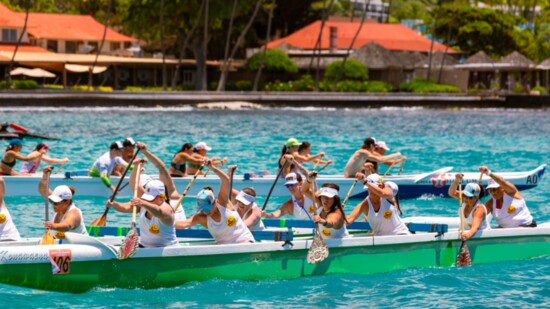The Queen Lili‘uokalani Canoe Race, with a course spanning 18 miles along the Kona Coast, is the world’s largest outrigger canoe long-distance race, attracting some 3,000 paddlers annually from 13 countries worldwide. Hosted by Kailua-Kona’s Kai‘opua Canoe Club, formed in 1929 and one of the oldest clubs in the state, the first race took place on Saturday, September 2, 1972, with a specific purpose.
"The race was established by club officials to provide paddlers with a challenging warm-up for the much more rigorous Molokai Channel Race held each fall – a 41-mile journey between Molokai and O‘ahu. The September 2 date also offers an opportunity to honor the queen, who was born on that day in 1838," Kris Hazard, Kai‘opua Canoe Club president, says. "While the second doesn’t always fall on race day Saturday, the five days of race festivities always take place over the Labor Day weekend."
Currently, Kai‘opua boasts 300 members, while numerous clubs throughout the islands bring the count to more than 2,500 competitive paddlers in the islands. According to club officials, members of the canoe clubs who are strictly recreational paddlers add thousands of paddling enthusiasts to the count. Kris says the clubs offer more than recreation; they offer exciting sporting events and camaraderie and preserve treasured, traditional Hawaiian practices.
Kris also shares that with most of the entrants originally from the islands, the mainland U.S. and a few Pacific Rim countries, today, serious racers from around the globe travel tens of thousands of miles or more each year to participate.
While the sport continues to grow in popularity internationally, outrigger canoe paddling is a cultural treasure of historic significance in Hawai‘i and was designated the state’s official team sport in 1998. Celestial navigators, the islands’ first settlers from Polynesia, traveled more than 2,000 miles across the open ocean in double-hulled voyaging canoes to reach these shores. The migration began sometime between 1000 and 1200 AD, and these voyagers brought their culture, agricultural practices and social systems, according to historians.
This year, Kai‘opua extended its commitment to celebrating and enhancing awareness of Hawaiian culture and history by partnering with the Daughters of Hawai‘i, a historical society dedicated to preserving the cultural legacy of the Hawaiian Islands, including the Huli‘hee Palace in the heart of Kailua-Kona. Located on Ali‘i Drive’s historic waterfront and fronting the start/finish lines of the Queen Lili‘uokalani Canoe Race in Kailua Bay, the Palace was the Royal family’s summer vacation home from the time it was built in 1838 up until the time the islands were annexed to the United States in 1898. Queen Lili‘uokalani was a frequent visitor to the Palace before and during her reign from 1891 to 1893, which ended in a coup d’etat against her.
The Palace was in serious disrepair when the Territorial Government purchased it in 1925, and it was turned over to the Daughters of Hawai‘i to maintain and establish as a museum. In 1973, it was placed on the National Register of Historic Places and features artifacts from the monarch era of rule. It features royal family portraits, koa wood furniture and artwork, including tapa cloth, feather work, and Hawaiian quilts, among other treasured objects. Docent-led and self-guided tours are offered Wednesdays through Saturdays.
"As part of an effort to welcome even more visitors and island residents to the Palace, our vision now includes partnering with like-minded non-profit, as well as for-profit organizations to co-host events on these sacred grounds," Manu Powers, regent and president of the Daughters of Hawai‘i, says. "Planning sessions are underway now to discuss how we can improve and build upon what we offered during the 2024 race activities for the 2025 event."
This year, a welcome reception for international race participants was hosted inside the Palace on Thursday night. A complimentary Talk Story presentation by Micah Kamohoali‘i, open to the public, took place on the Palace lawn on Friday afternoon, including kane (male) hula performed by Micah’s cousin Stallone. Micah, who descends from a long line of Native Hawaiian practitioners and artisans, is an internationally respected kumu (teacher) hula, historian and artist whose work is rooted in traditional Hawaiian knowledge and practices. In his signature, entertaining style, Micah’s storytelling on Friday focused on the historic sites and wahi pana around Kailua Bay. Wahi Pana, he says, are sacred, legendary places in Hawaiian culture – places that are imbued with mana (spiritual power).
"We’ve always been mindful of respecting the places, culture and people of Hawai‘i Island. Partnering with the Daughters of Hawai‘i has heightened our ability to share the island’s rich history with an international audience," Kris says.
Understanding the cultural significance of canoe paddling, Kris shares, "Although I wasn’t ‘born in a canoe’ like many of our 70-year-old plus Kai‘opua club members, I fell in love with the sport and its history when I moved here permanently from California. I just couldn’t wait to get into a canoe."
She did just that by starting out paddling recreationally in 2005, becoming a member of Kai‘opua in 2006 and then serving on the board in various capacities for several years before becoming its president in 2022.
"I love the idea that we are carrying on one of the many traditions of the early Hawaiians and sharing it with the world," she says. Kris is also proud that all Hawaiian Islands’ canoe clubs were well represented this year, scoring medals in various race divisions.
Now it’s all about imua (moving forward) to race day 2025!
Learn more at QLCanoeRace.com.
The September 2 date also offers an opportunity to honor the queen, who was born on that day in 1838 — Kris Hazard, Kai‘opua Canoe Club president.
We are carrying on one of the many traditions of the early Hawaiians and sharing it with the world.
